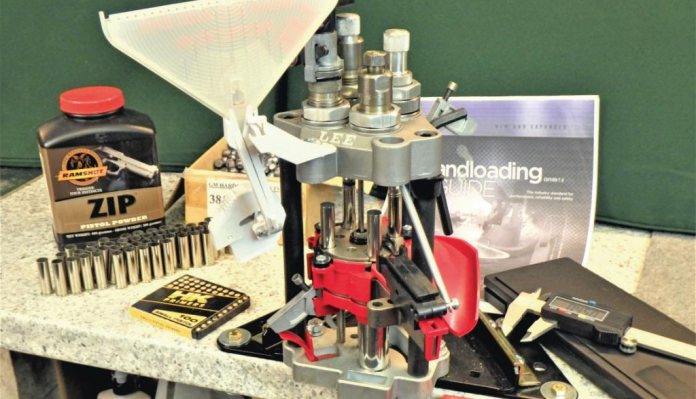Reloading Basics - Straight Walled Ammunition
-
38
 Comments
Comments
- Last updated: 05/05/2022

There are a few differences between reloading bottlenecked rifle cartridges and the straightwalled cartridges commonly used in handgun calibres, like .357 Magnum and .44. These types of cartridges can usually be reloaded quicker because they require fewer steps to complete and progressive presses, designed to produce ammunition in much higher quantities than other types of presses, are generally intended for making straight-walled cartridges and not bottlenecked rifle ammunition.
The die sets required for straight-walled cartridges are also a bit different from those used for producing bottlenecked ammunition. The pistol-calibre die sets usually contain three dies instead of two, so a depriming and resizing die, an expanding and flaring die and a seating/crimp die.
If you are going to be producing a lot of ammunition, particularly on a progressive press, you need to clean your brass before you start, to prevent carbon deposits and dirt from contaminating your dies. The more cases you feed through your dies, the more deposits will build up and the high production presses can clog up fast if fed a lot of dirty brass. Cleaning brass before you start reloading is always a good idea.
The depriming and resizing of straight-walled brass is very similar to the process used for bottlenecked cases. The main difference is that you generally do not need to use case lube when you run the brass through the die, because there is less surface area and therefore less friction. One exception to this is large calibre straight walled cases like .45-70 Government, which have such a large surface area you do need to use a case lubricant to ensure the brass does not get stuck in the die.
Priming straight-walled brass is no different to the process you use for bottlenecked cases and the tools you use are also the same.
Unlike the process of resizing bottlenecked cases, with straightwalled types you need to expand and flare your brass so it can accept a bullet. This is done using the expanding and flaring die, which you can adjust so that you expand the case mouth just enough. You are aiming for the minimum amount necessary for your bullets to start into the case without being damaged. If you omit this step and try to seat a bullet, your brass will shave off the copper jacket or some lead from your bullet. Adjusting an expander die is a process of gradually increasing the amount of flare, and trying to sit a bullet into the case mouth until it just sits nicely, without catching on the edge of the brass.
This flare will be removed when the bullet is seated and crimped in place and this whole process will stress the brass. Using only the minimum amount of flare will minimise this stress and so extend the life of your cases.
The case expanding die also allows you to add the powder charge to the case, through the centre of the die, and this can be automated using a powder measure or done manually with a funnel and a powder scoop.
Seating bullets in straight-walled cartridges is usually done with a combined bullet seat/crimp die that is supplied in the die set. You can ‘back out’ these dies to prevent any crimp from being applied and then use a separate crimping die to apply a more specific type of crimp, such as a taper or roll crimp. The taper crimp is used on calibres that headspace on the case mouth, like a self-loading pistol calibre such as .45 ACP. Roll crimps are used on revolver-calibre cartridges and, as the name suggests, they apply a radius or ‘roll’ to the edge of the case mouth. It can take a bit of time to get your die adjusted properly, for both seating the bullet and the crimp, but it is an important step because it is required to remove the flare you applied and to add additional caseneck tension to grip the bullet.
The seater/crimp die instructions should be followed closely and you will need to experiment to get the seating depth and the crimp right if you are using the one die to do both jobs simultaneously. If you apply too much crimp then the bullet seater can damage softnosed bullets. Many reloaders use a separate crimp die to avoid this type of damage and to have more control over the crimp being applied.
Straight walled cases that are used for standard, nonmagnum loads, tend to require very little trimming. This is because when you fire a straight-walled cartridge the pressure pushes solely on the base of the bullet as it leaves. On a bottlenecked cartridge, the pressure pushes on the bullet and on the inside surface of the shoulder, driving it forward and pulling on the walls of the case. This is why trimming is typically required more often. Nevertheless, it is worth occasionally checking your case lengths and trimming them all to the same length if necessary. Consistency across each piece of brass is critical to ensure an effective and consistent crimp when you seat the bullet.
General case maintenance, including primer pocket cleaning, is no different to that required on any other type of case. While it is not really critical to clean out primer pockets every time you reload the brass, it is worth doing it every four or five reloadings, just to ensure the build-up of carbon does not get too bad.
Reloading straight-walled cartridges is normally much easier than bottlenecked ones and the only real difference is the flaring and crimping of the case mouths. These operations do stress the brass, but generally, straight-walled cases will last much longer than their bottlenecked cousins.
